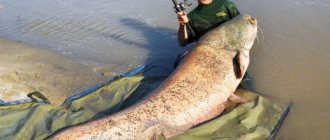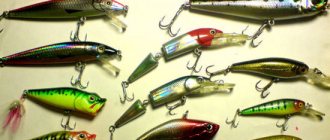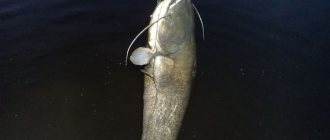Channel catfish is originally from Canada, and this fish began to be artificially bred in America, back in the middle of the last millennium. Nowadays, it is found in our reservoirs, in almost all CIS countries. The fish has delicious meat, which attracts fishermen. In addition, the process of catching it is quite interesting and exciting. Unfortunately, the channel catfish does not live everywhere and must be looked for while traveling hundreds of kilometers from the city. Currently, this problem has begun to be solved in paid reservoirs by artificially breeding many interesting species of fish, such as carp, tench, sturgeon, including channel catfish. Similar reservoirs are available almost next to any city, located in the suburban area. Therefore, traveling hundreds of kilometers to catch, for example, trout or channel catfish, simply does not make sense. In addition, fishing on a paid reservoir can be much cheaper if you accurately calculate all the costs.
Channel catfish have very tasty meat that just melts in your mouth. If you haven't tried it, be sure to try it by going to a paid reservoir.
What to use to catch channel catfish
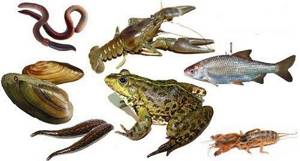
Before you go fishing, you need to decide what to fish for, such as channel catfish. As a rule, this type of fish is caught using the same baits as its relative, river catfish. The only difference is that channel catfish are smaller in size.
The following baits can be used to catch channel catfish:
- live bait;
- pieces of fish;
- pieces of meat;
- worm;
- grasshoppers;
- locusts;
- large caterpillars;
- frogs;
- insect larvae.
Live bait is not a bad bait. Moreover, it can be caught in the same body of water. In this case, a fishing line with a thickness of 0.3 mm, no more, is used, equipped with a single or double hook No. 8-10. It makes no sense to use a metal leash, since the catfish is not able to bite the fishing line, and the live bait will not be able to play believably. You can get good results if you use a crawl. It is one of the channel catfish's favorite foods, so it is advisable to start fishing with this bait.
When fishing for channel catfish, it makes sense to experiment with baits. It can also peck on baits of plant origin, such as pearl barley or corn. Unfortunately, this is an accident rather than a pattern, since catfish are, first of all, a predator that will always give preference to bait of animal origin.
Channel catfish can be caught with a variety of gear, such as a float rod, feeder or spinning rod. The equipment is selected depending on the size of the fish that is found in a given reservoir. As a rule, you won’t need a hook larger than number 10.
Choosing a fishing rod
The channel catfish is a worthy opponent. Even two-kilogram specimens can offer the same resistance as a river pike weighing about 6 kg. And if fishing takes place near snags, then the tackle must be especially strong. Then it will be possible to keep a large individual from falling into a snag. For this, fishermen came up with two options for gear.
Rod for vertical fishing
Somyatniks use their usual fishing rod without a float.
- The rod is selected with high strength, which can withstand heavy loads when casting heavy equipment. The length of the form should be 5-7 m, with preference given to lighter modifications. This is explained by the fact that the tackle has to be held in hands for a long time. The test indicator should be in the range of 40-100 g.
- When choosing a spinning reel, you need to take into account the weight and power of the model. The spool must hold a good supply of fairly thick fishing line. For example, there should be 100 m of 0.28 mm line on the reel. As an alternative, fishermen use inertial models, the drum diameter of which will be within 120 mm. The advantage of old coils is their lower weight with the same power as “meat grinders”. In addition, simple reels are resistant to dirt and sand. The only drawback of the drum design is the lack of a friction brake. For this reason, you will have to hold the line with your finger when fishing.
- When fishing for channel catfish occurs at night, a “firefly” becomes a necessary element of the gear. It is attached to the tip of the rod using tape.
- Catching catfish with a fishing rod follows the following scheme. After casting the rig, a pause is made to allow the bait to reach the bottom. Following this, the fishing line is stretched so that the tip of the fishing rod bends slightly. A fish bite looks like a sharp movement of a telescope towards the surface of the water.
Bottom fishing rod
Bottom tackle looks a little different.
- The role of the fishing rod is played by a duralumin or fiberglass spinning rod with a length of 2.4-2.7 m. The test load should be from 60 to 120 g.
- It is more convenient to equip a bottom fishing rod with an inertia-free reel, then you will not have to periodically untangle the “beard” that inertial models tend to form.
- A fishing line with a diameter of 0.3-0.5 mm is wound onto the reel spool.
- When fishing for donks, you can’t do without rod stands. Since you often have to change the place of fishing, it is preferable to make a portable support made of stainless steel with a thickness of 6-8 mm. To do this, it is enough to sharpen the metal rod so that you can stick it into any bank without any problems.
- A bell is usually used as a bite alarm. It is better to tie it with a nylon thread to a fishing rod or stand so that after hooking it does not fly into the water.
Where and when to catch channel catfish

The channel catfish was brought to us from America, where it is considered the most numerous fish from the catfish family. Starting in 1972, it began to be bred in the Kuban, after which it entered the Don and Kuban river system. It has successfully taken root in reservoirs that are connected to warm water from state power plants and thermal power plants. Its largest population is noted here. Catfish are bred artificially in many ponds with warm water. Able to survive slight frosts if the reservoir has appropriate depths. Prefers to be at depths of 1 to 1.5 meters. If a reservoir is covered with ice, then it needs depths of at least 3 meters. This is the only way he can survive the winter. After all, the deeper it is, especially in winter, the more stable the water temperature.
Channel catfish choose creeks overgrown with vegetation, namely reeds. This is where his feeding table is located. Therefore, by throwing bait into this area, you can hope for a bite. This fish can be caught at any time of the day. Despite this, you will have to wait a long time for a bite. He likes to rest in his burrows and only comes out to search for food. It is because of this that you have to wait a long time until the catfish goes for a walk. If this happens, then he is able to sense the bait at a great distance. Therefore, fishing for channel catfish is a complete wait.
Appearance and dimensions
As already mentioned, the channel catfish is significantly smaller than its river counterpart, its length can reach a maximum of one and a half meters, and its weight is 26 kilograms, however, these are the most record figures, and if you look at videos of catching channel catfish on the Internet, then fishermen usually come across much more small specimens.
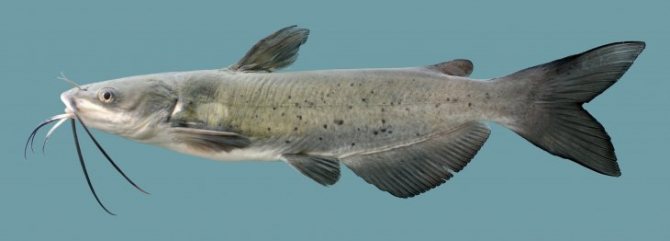
In addition, these indicators are valid for Western countries, but in our country, due to the harsher climate, the size of this fish is even smaller, reaching an average of three kilograms.
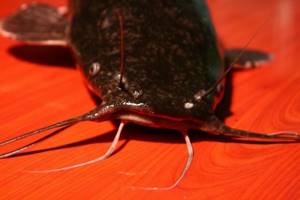
However, this is enough for most fishermen, because the meat of this type of catfish is quite tasty.
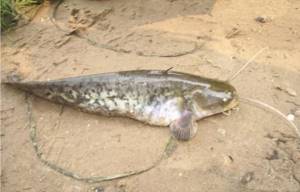
In appearance, this fish, of course, most closely resembles its river relative. Brown in color with a naked, sometimes spotted body, and males usually have a darker body color.
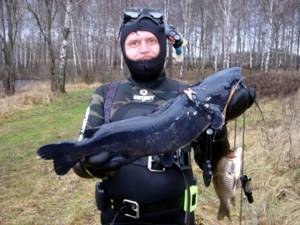
After looking at several photos of channel catfish caught in different reservoirs and regions, you can see that many individuals also differ in the length of their whiskers and the shape of their dorsal fin.
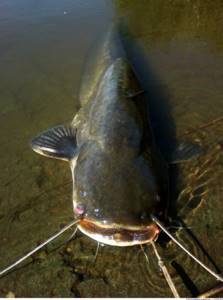
The channel catfish itself comes from the west, from Canada and some states of the USA, where it is one of the most common types of catfish and is also eaten.
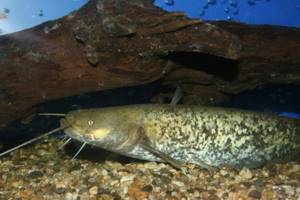
In 1972, this type of fish began to be artificially bred in the Kuban, after which it spread virtually throughout the entire country.
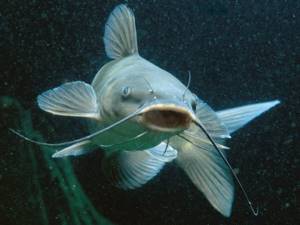
Channel catfish spawning
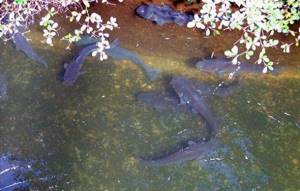
The spawning process of this interesting fish cannot be ignored. The uniqueness lies in the fact that this is one of those rare species of fish that protects its offspring.
The beginning of spawning begins with real mating fights, in which the males enter. Moreover, the fights are so active that they lead to bad outcomes and even death. The fact is that males can inflict serious wounds on their opponents, as a result of which they become infected, which leads to the death of the individual. After the fights, the males choose their females and go to the place where the eggs will be laid. Spawning takes place at a temperature of +25°C-+28°C.
The male independently prepares the nest, making a depression and freeing the space from silt and debris. If the female is not ready to lay eggs, then he can drive her away from her nest. The spawning process lasts from 4 to 12 hours. The female lays eggs in layers, and the male fertilizes them layer by layer. After the female has laid eggs, the male drives her away from the nest and does not allow her near the offspring anymore. It not only protects the laying of eggs, it constantly works with its fins to attract fresh water to the eggs. Moreover, he regularly shakes it, as it were, so that fresh water can flow to all the eggs.
After the appearance of small catfish, the behavior of the male also changes. Now he does not work roughly and does not shake the masonry, but makes very subtle movements with his fins to again provide the fry with fresh water. After 2-3 days the fry begin to leave their nest.
It seems like nothing remarkable, but how interesting is this fish. In America, about 8 million anglers fish for channel catfish.
Pond cultivation
When breeding this species, one of three methods is used: in aquariums, pool gardens or ponds. Pond farming is most often used as the simplest and most economical method, which does not require the purchase of expensive equipment, and labor costs are minimal. When choosing a site for constructing a pond, take into account the following features:
- topography of the area;
- quality and composition of soils;
- volume and quality of water.
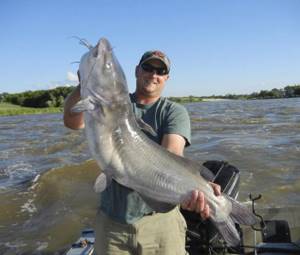
The optimal depth for such a reservoir is considered to be 0.9-2 m on the southern side and 1.8-3.5 m on the northern side, where shallow water may freeze in severe winters. Reservoirs are stocked with fish in the spring, when the water has already warmed up to 13-15°C. At this time, the loss of fry is noticeably less than during the autumn release of fry. In addition, the “spring” fry immediately begin to grow rapidly. Despite the fact that the main food in such conditions is artificial food, the channel catfish receives a certain amount of food from the natural food supply of the pond.
